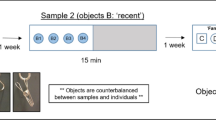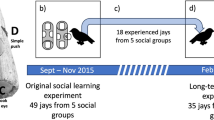Abstract
Understanding animal episodic-like memory is important for tracing the evolution of the human mind. However, our knowledge about the existence and nature of episodic-like memory in non-human primates is minimal. We observed the behaviour of a wild male chacma baboon faced with a trade-off between protecting his stationary group from aggressive extra-group males and foraging among five out-of-sight platforms. These contained high-priority food at a time of natural food shortage. In 10 morning and eight evening trials, the male spontaneously visited the platforms in five and four different sequences, respectively. In addition, he interrupted foraging sequences at virtually any point on eight occasions, returning to the group for up to 2 h. He then visited some or all of the remaining platforms and prevented revisits to already depleted ones, apparently based on his memory for the previous foraging episode about food value, location, and time. Efficient use of memory allowed him to keep minimal time absent from his group while keeping food intake high. These findings support the idea that episodic-like memory offers an all-purpose solution to a wide variety of problems that require flexible, quick, yet precise decisions in situations arising from competition for food and mates in wild primates.



Similar content being viewed by others
References
Allen T, Fortin N (2013) The evolution of episodic memory. PNAS 110:10379–10386
Babb S, Crystal J (2005) Discrimination of what, when, and where: implications for episodic-like memory in rats. Learn Mot 36:177–189
Babb S, Crystal J (2006) Episodic-like memory in the rat. Curr Biol 16:1317–1321
Basil B, Hampton R (2011) Monkeys recall and reproduce simple shapes from memory. Curr Biol 21:774–778
Bates D, Maechler M, Bolker B, Walker S (2014) lme4: linear mixed-effects models using Eigen and S4 classes. R package version 10–7
Beran MJ (2014) Animal memory: rats bind event details into episodic memories. Curr Biol 24:R1159–R1160
Clayton N, Dickinson A (1998) Episodic-like memory during cache recovery by scrub jays. Nature 395:272–274
Clayton N, Bussey T, Dickinson A (2003) Can animals recall the past and plan for the future? Nat Rev Neurosci 4:685–691
Clayton N, Salwiczek L, Dickinson A (2007) Episodic memory. Curr Biol 17:R189–R191
Crystal J (2010) Episodic-like memory in animals. Behav Brain Res 215:235–243
Eacott M, Norman G (2004) Integrated memory for object, place, and context in rats: a possible model of episodic-like memory? J Neurosci 24:1948–1953
Eacott M, Easton A, Zinkivskay A (2005) Recollection in an episodic-like memory task in the rat. Learn Mem 12:221–223
Feeney M, Roberts W, Sherry D (2009) Memory for what, where, and when in the black-capped chickadee (Poecile atricapillus). Anim Cogn 12:767–777
Ferkin M, Combs A, delBarco-Trillo J, Pierce A, Franklin S (2008) Meadow voles, Microtus pennsylvanicus, have the capacity to recall the “what”, “where”, and “when” of a single past event. Anim Cogn 11:147–159
Fivush R (2011) The development of autobiographical memory. Annu Rev Psychol 62:559–582
Friedman W (1993) Memory for the time of past events. Psychol Bull 113:44–66
Genovesio A, Wise SP, Passingham RE (2014) Prefrontal-parietal function: from foraging to foresight. TICS 18:72–81
Gonzalez-Gomez P, Bozinovic F, Vasquez R (2011) Elements of episodic-like memory in free-living hummingbirds, energetic consequences. Anim Behav 81:1257–1262
Hampton R, Hampstead B, Murray E (2005) Rhesus monkeys (Macaca mulatta) demonstrate robust memory for what and where, but not when, in an open-field test of memory. Learn Mot 36:245–259
Hoffman M, Beran M, Washburn D (2009) Memory for “what”, “where”, and “when” information in rhesus monkeys (Macaca mulatta). J Exp Psychol 35:143–152
Holland S, Smulders T (2011) Do humans use episodic memory to solve a what-where-when memory task? Anim Cogn 14:95–102
Janmaat KRL, Polansky L, Ban SD, Boesch C (2014) Wild chimpanzees plan their breakfast time, type and location. PNAS 111:16343–16348
Janson CH (1998) Experimental evidence for spatial memory in foraging wild capuchin monkeys. Anim Behav 55:1229–1243
Joels M, Pu Z, Wiegert O, Oitzl M, Krugers H (2006) Learning under stress: how does it work? TICS 10:152–158
Jozet-Alves C, Bertin M, Clayton N (2013) Evidence of episodic-like memory in cuttlefish. Curr Biol 23:R1033–R1035
King A, Douglas C, Huchard E, Isaac N, Cowlishaw G (2008) Dominance and affiliation mediate despotism in a social primate. Curr Biol 18:1833–1838
Kouwenberg A, Walsh C, Morgan B, Martin G (2009) Episodic-like memory in crossbred Yucatan minipigs (Sus scrofa). Appl Anim Behav Sci 117:165–172
Martin-Ordas G, Haun D, Colmenares F, Call J (2010) Keeping track of time: evidence for episodic-like memory in great apes. Anim Cogn 13:331–340
Menzel CR (1999) Unprompted recall and reporting of hidden objects by a chimpanzee (Pan troglodytes) after extended delays. J Comp Psychol 113:426–434
Menzel CR (2005) Progress in the study of chimpanzee recall and episodic memory. In: Terrace H, Metcalfe J (eds) The missing link in cognition. Origins of self-reflective consciousness. Oxford University Press, Oxford, pp 188–224
Noser R, Byrne RW (2007) Travel routes and planning of visits to out-of-sight resources in wild chacma baboons (Papio ursinus). Anim Behav 73:257–266
Noser R, Byrne RW (2010) How do wild chacma baboons (Papio ursinus) plan their routes? Travel among multiple high-quality food sources with inter-group competition. Anim Cogn 13:145–155
Palombit RA, Cheney D, Seyfarth R, Rendall D, Silk J, Johnson S, Fischer J (2000) Male infanticide and defense of infants in chacma baboons. In: van Schaik CP, Janson CH (eds) Male infanticide and its implications. Cambridge University Press, Cambridge, pp 123–151
Pause B, Zlomuzica A, Kinugawa K, Mariani J, Pietrowsky R, Dere E (2013) Perspectives on episodic-like and episodic memory. Front Behav Neurosci 7:1–12
R Core Team (2013) R: a language and environment for statistical computing. R Foundation for Statistical Computing, Vienna
Raby C, Clayton N (2012) Episodic memory and planning. In: Vonk J, Shackelford T (eds) The Oxford handbook of comparative evolutionary psychology. Oxford University Press, Oxford, pp 217–235
Roberts W (1998) Principles of animal cognition. McGraw-Hill, Boston
Roberts W (2002) Are animals stuck in time? Psychol Bull 128:473–489
Roberts W, Feeney M (2009) The comparative study of mental time travel. TICS 13:271–277
Sandi C, Pinelo-Nava M (2007) Stress and memory: behavioral effects and neurobiological mechanisms. Neural Plast. doi:10.1155/2007/78970
Sayers K, Menzel CR (2012) Memory and forging theory: chimpanzee utilization of optimality heuristics in the rank-order recovery of hidden foods. Anim Behav 84:795–803
Scarf D, Gross J, Colombo M, Hayne H (2013) To have and to hold: episodic memory in 3- and 4-year-old children. Dev Psychobiol 55:125–132
Schwartz B (2005) Do nonhuman primates have episodic memory? In: Terrace H, Metcalfe J (eds) The missing link in cognition. Origins of self-reflective consciousness. Oxford University Press, Oxford, pp 225–241
Schwartz B, Hoffman M, Evans S (2005) Episodic-like memory in a gorilla: a review and new findings. Learn Mot 36:226–244
Stolba A (1979) Entscheidungsfindung in Verbänden von Papio hamadryas. Dissertation, University of Zurich
Suddendorf T, Busby J (2003) Mental time travel in animals. TICS 7:391–396
Suddendorf T, Corballis M (2007) The evolution of foresight: what is mental time travel, and is it unique to humans? Behav Brain Sci 30:299–313
Tulving E (1983) Elements of episodic memory. Clarendon, Oxford
Tulving E (2005) Episodic memory and autonoesis: uniquely human? In: Terrace H, Metcalfe J (eds) The missing link in cognition: origins of self-reflective consciousness. Oxford University Press, Oxford, pp 3–56
Wolf O (2009) Stress and memory in humans: twelve years of progress? Brain Res 1293:142–154
Zeigarnik B (1927) Das Behalten erledigter und unerledigter Handlungen. Psychol Forschung 9:1–85
Zentall T, Clement T, Bhatt R, Allen J (2001) Episodic-like memory in pigeons. Psychon Bull Rev 8:685–690
Zinkivskay A, Nazir F, Smulders T (2009) What-where-when memory in magpies (Pica pica). Anim Cogn 12:119–125
Acknowledgments
We thank the Parks Board of the Limpopo Province, South Africa, for permission to conduct this study at Blouberg Nature Reserve; Ralph Schwarz, Martina Brägger and Beat Egger for assistance, and Janine and Peter Snyman for logistic support in the field; Ken Sayers and an anonymous reviewer for valuable comments on an earlier draft of this manuscript. This study was supported by grants from Zürcher Hochschulverein, Schweizerische Akademie für Naturwissenschaften, Stiftung Thyll-Dürr, and Stiftung Annemarie Schindler, to R.N. In memory of Peter Snyman.
Author information
Authors and Affiliations
Corresponding author
Rights and permissions
About this article
Cite this article
Noser, R., Byrne, R.W. Wild chacma baboons (Papio ursinus) remember single foraging episodes. Anim Cogn 18, 921–929 (2015). https://doi.org/10.1007/s10071-015-0862-4
Received:
Revised:
Accepted:
Published:
Issue Date:
DOI: https://doi.org/10.1007/s10071-015-0862-4




